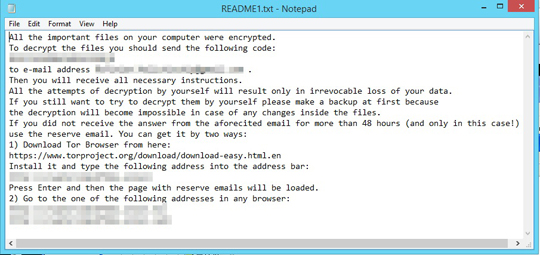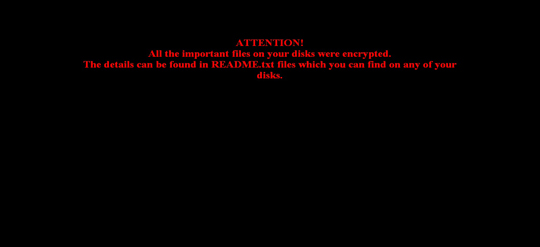RANSOM_CRYPSHED.D
Windows

Threat Type:
Trojan
Destructiveness:
No
Encrypted:

In the wild::
Yes
OVERVIEW
Puede haberlo descargado otro malware/grayware/spyware desde sitios remotos.
Descarga un archivo desde un determinado localizador uniforme de recursos (URL) y le cambia el nombre posteriormente antes de almacenarlo en el sistema afectado. Después ejecuta los archivos descargados. Como resultado, en el sistema afectado se muestran las rutinas maliciosas de los archivos descargados.
Se conecta a determinados sitios Web para enviar y recibir información.
TECHNICAL DETAILS
Detalles de entrada
Puede haberlo descargado el siguiente malware/grayware/spyware desde sitios remotos:
- JS_CRYPSHED.B
Instalación
Crea las siguientes copias de sí mismo en el sistema afectado:
- %All Users Profile%\Application Data\Windows\csrss.exe (Windows XP and below)
- %All Users Profile%\Windows\csrss.exe (Windows Vista and above)
Infiltra los archivos siguientes:
- %Application Data%\{8 Random Alphanumeric Characters}{Same Characters as first 8}.bmp
- %User Temp%\cached-certs
- %User Temp%\cached-microdesc-consensus
- %User Temp%\cached-microdescs.new
- %User Temp%\lock
- %User Temp%\state
(Nota: %Application Data% es la carpeta Application Data del usuario activo, que en el caso de Windows 98 y ME suele estar ubicada en C:\Windows\Profiles\{nombre de usuario}\Application Data, en el caso de Windows NT en C:\WINNT\Profiles\{nombre de usuario}\Application Data y en el caso de Windows 2000, XP y Server 2003 en C:\Documents and Settings\{nombre de usuario}\Local Settings\Application Data).
. %User Temp% es la carpeta Temp del usuario activo, que en el caso de Windows 2000, XP y Server 2003 suele estar en C:\Documents and Settings\{nombre de usuario}\Local Settings\Temp).)Deja archivos de texto a modo de notas de rescate que contienen lo siguiente:

- {Root Drives}\README{number 1 to 10}.txt
- %System Root%\Users\Public\Public Desktop\README{number 1 to 10}.txt (Windows Vista and Above)
- %All Users Profile%\Desktop\README{number 1 to 10}.txt (For Windows XP and Below)
- %Desktop%\README{number 1 to 10).txt
Técnica de inicio automático
Agrega las siguientes entradas de registro para permitir su ejecución automática cada vez que se inicia el sistema:
HKEY_CURRENT_USER\Software\Microsoft\
Windows\CurrentVersion\Run
Client Server Runtime Subsystem = %All Users Profile%\Application Data\Windows\csrss.exe (Windows XP and below)
HKEY_CURRENT_USER\Software\Microsoft\
Windows\CurrentVersion\Run
Client Server Runtime Subsystem = %All Users Profile%\Windows\csrss.exe (Windows Vista and above)
Otras modificaciones del sistema
Agrega las siguientes entradas de registro como parte de la rutina de instalación:
HKEY_LOCAL_MACHINE\SOFTWARE\System32\
Configuration
HKEY_CURRENT_USER\SOFTWARE\System32\
Configuration
Agrega las siguientes entradas de registro:
HKEY_LOCAL_MACHINE\SOFTWARE\System32\
Configuration
pk = {PUBLIC KEY}
HKEY_LOCAL_MACHINE\SOFTWARE\System32\
Configuration
cnt = {numbers}
HKEY_LOCAL_MACHINE\SOFTWARE\System32\
Configuration
mode = 0
HKEY_LOCAL_MACHINE\SOFTWARE\System32\
Configuration
state = 5
HKEY_LOCAL_MACHINE\SOFTWARE\System32\
Configuration
i = {random characters}
HKEY_LOCAL_MACHINE\SOFTWARE\System32\
Configuration
Version = 7.2.0.3
HKEY_CURRENT_USER\SOFTWARE\System32\
Configuration
pk = {PUBLIC KEY}
HKEY_CURRENT_USER\SOFTWARE\System32\
Configuration
cnt = {numbers}
HKEY_CURRENT_USER\SOFTWARE\System32\
Configuration
mode = 0
HKEY_CURRENT_USER\SOFTWARE\System32\
Configuration
state = 3
HKEY_CURRENT_USER\SOFTWARE\System32\
Configuration
i = {random characters}
HKEY_CURRENT_USER\SOFTWARE\System32\
Configuration
Version = 7.2.0.3
HKEY_LOCAL_MACHINE\SOFTWARE\System32\
Configuration
sys = 1
HKEY_CURRENT_USER\SOFTWARE\System32\
Configuration
sys = 1
Modifica las siguientes entradas de registro:
HKEY_CURRENT_USER\Control Panel\Desktop
wp = "%Application Data%\{random characters}.bmp"
(Note: The default value data of the said registry entry is "{user-defined}".)
Este malware establece la imagen siguiente como fondo de escritorio del sistema:
- %Application Data%\{8 random alphanumeric characters}{Same characters as first 8}.bmp

Rutina de descarga
Descarga archivos desde los siguientes localizadores uniformes de recursos (URL) y les cambia el nombre posteriormente antes de almacenarlos en el sistema afectado:
- URLs varies based from the list received from the servers
Guarda los archivos que descarga con los nombres siguientes:
- %User Temp%\{8 Random Alphanumeric Strings}.exe
(Nota: %User Temp% es la carpeta Temp del usuario activo, que en el caso de Windows 2000, XP y Server 2003 suele estar en C:\Documents and Settings\{nombre de usuario}\Local Settings\Temp).
)Después ejecuta los archivos descargados. Como resultado, en el sistema afectado se muestran las rutinas maliciosas de los archivos descargados.
Robo de información
Recopila los siguientes datos:
- Computer Information
- Network Information
- IP Address
- List of Logical Drives
- User Name
- OS Version
Otros detalles
Se conecta al sitio Web siguiente para enviar y recibir información:
- http://{server}/{path}
where {server} can be any of the following:- {BLOCKED}.{BLOCKED}.40.189
- {BLOCKED}.{BLOCKED}.32.5
- {BLOCKED}.{BLOCKED}.0.39
- {BLOCKED}.{BLOCKED}.21.38
- {BLOCKED}.{BLOCKED}.206.212
- {BLOCKED}.{BLOCKED}.251.203
- {BLOCKED}.{BLOCKED}.17.194
- {BLOCKED}.{BLOCKED}.244.244
- {BLOCKED}.{BLOCKED}.223.34
- {BLOCKED}.{BLOCKED}.193.9
- http://{BLOCKED}h2ldj3v.onion
- reg.php
- prog.php
- err.php
- cmd.php
- sys.php
Cifra los archivos con las extensiones siguientes:
- edml
- raw
- jpg
- jpeg
- jpe
- bmp
- png
- tif
- tiff
- dib
- gif
- svg
- svgz
- rle
- tga
- vda
- icb
- wbm
- wbmp
- jpf
- jpx
- jp2
- j2k
- j2c
- jpc
- avi
- mkv
- mov
- mp4
- wmv
- 3gp
- mpg
- mpeg
- m4v
- divx
- mpv
- m1v
- dat
- anim
- m4a
- qt
- 3g2
- f4v
- mkidx
- mka
- avs
- vdr
- flv
- bin
- mp3
- wav
- asx
- pls
- zip
- 7z
- rar
- tar
- gz
- bz2
- wim
- xz
- c
- h
- hpp
- cpp
- php
- php3
- php4
- php5
- py
- pl
- sln
- js
- json
- inc
- sql
- java
- class
- ini
- asm
- clx
- tbb
- tbi
- tbk
- pst
- dbx
- cbf
- crypted
- tib
- eml
- fld
- vbm
- vbk
- vib
- vhd
- 1cd
- dt
- cf
- cfu
- mxl
- epf
- vrp
- grs
- geo
- elf
- lgf
- lgp
- log
- st
- pff
- mft
- efd
- md
- dmp
- fdb
- lst
- fbk
- sw
- vdw
Sustituye los nombres de los archivos cifrados por los nombres siguientes:
- {random characters}.better_call_saul
- {Original File Name}.los_pollos - if filename encryption fails
SOLUTION
Step 1
Los usuarios de Windows ME y XP, antes de llevar a cabo cualquier exploración, deben comprobar que tienen desactivada la opción Restaurar sistema para permitir la exploración completa del equipo.
Step 4
Reiniciar en modo seguro
Step 5
Eliminar este valor del Registro
Importante: si modifica el Registro de Windows incorrectamente, podría hacer que el sistema funcione mal de manera irreversible. Lleve a cabo este paso solo si sabe cómo hacerlo o si puede contar con ayuda de su administrador del sistema. De lo contrario, lea este artículo de Microsoft antes de modificar el Registro del equipo.
- In HKEY_CURRENT_USER\Software\Microsoft\Windows\CurrentVersion\Run
- Client Server Runtime Subsystem = %All Users Profile%\Application Data\Windows\csrss.exe (Windows XP and below)
- Client Server Runtime Subsystem = %All Users Profile%\Application Data\Windows\csrss.exe (Windows XP and below)
- In HKEY_CURRENT_USER\Software\Microsoft\Windows\CurrentVersion\Run
- Client Server Runtime Subsystem = %All Users Profile%\Windows\csrss.exe (Windows Vista and above)
- Client Server Runtime Subsystem = %All Users Profile%\Windows\csrss.exe (Windows Vista and above)
Step 6
Eliminar esta clave del Registro
Importante: si modifica el Registro de Windows incorrectamente, podría hacer que el sistema funcione mal de manera irreversible. Lleve a cabo este paso solo si sabe cómo hacerlo o si puede contar con ayuda de su administrador del sistema. De lo contrario, lea este artículo de Microsoft antes de modificar el Registro del equipo.
- In HKEY_LOCAL_MACHINE\SOFTWARE\System32
- Configuration
- Configuration
- In HKEY_CURRENT_USER\SOFTWARE\System32
- Configuration
- Configuration
Step 7
Buscar y eliminar este archivo
- %Application Data%\{8 Random Alphanumeric Characters}{Same Characters as first 8}.bmp
- %User Temp%\cached-certs
- %User Temp%\cached-microdesc-consensus
- %User Temp%\cached-microdescs.new
- %User Temp%\lock
- %User Temp%\state
- {Root Drives}\README{number 1 to 10}.txt
- %System Root%\Users\Public\Public Desktop\README{number 1 to 10}.txt (Windows Vista and Above)
- %All Users Profile%\Desktop\README{number 1 to 10}.txt (For Windows XP and Below)
- %Desktop%\README{number 1 to 10).txt
Step 8
Reinicie en modo normal y explore el equipo con su producto de Trend Micro para buscar los archivos identificados como RANSOM_CRYPSHED.D En caso de que el producto de Trend Micro ya haya limpiado, eliminado o puesto en cuarentena los archivos detectados, no serán necesarios más pasos. Puede optar simplemente por eliminar los archivos en cuarentena. Consulte esta página de Base de conocimientos para obtener más información.
Step 10
Restablecer las propiedades del escritorio
Did this description help? Tell us how we did.


